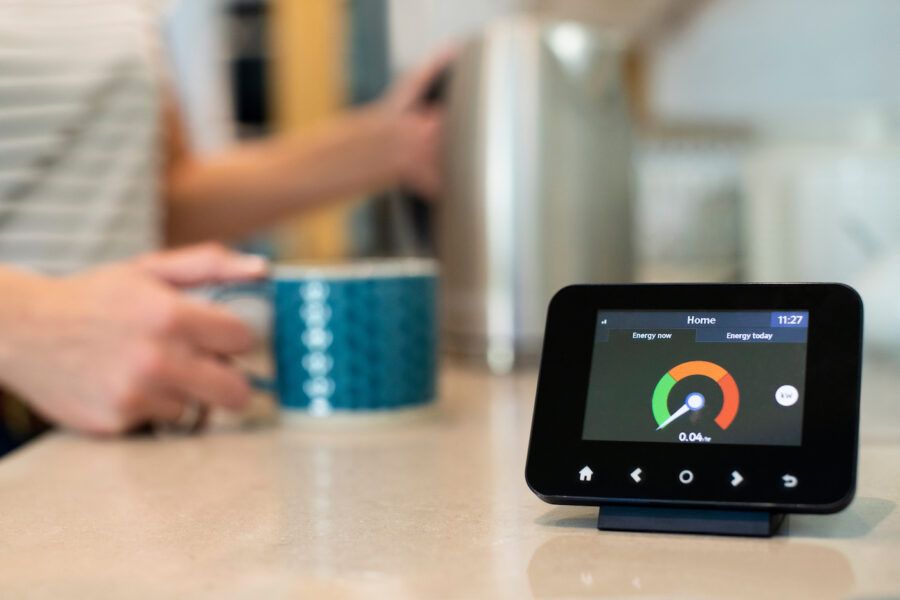In this article:
Adding smart technology such as high-tech thermostats and upgraded light bulbs to your home can help you efficiently regulate your energy use and reduce your utility bills. Monthly savings that result may be small, but over time you may see significant savings.
Consider the following factors when you think about adding smart technology to your home.
How to Save by Installing Smart Technology
Smart home tech is becoming more accessible and easier to use. Costs to purchase have gotten lower and devices have become easier to integrate with home hubs that can help you turn on music or shut off the lights. These electronic solutions provide convenience in your home, and they may also provide cost savings.
There are a variety of smart technology products that you can add to your home. Depending on what you'd like to control from an app or programmable hub, you could install:
- Smart/programmable thermostats to help control use of heating or air conditioning
- Smart lights and timers to help you turn on lights only when needed
- Smart sprinklers to help efficiently water your yard
Some smart technology can be added yourself, while other components require installation. Remember to factor in installation costs when shopping. This can help you estimate the correct savings from upgrading your home's technology.
Is Smart Home Technology Worth the Cost?
Though smart home technology can come with a sizable upfront cost, you may be able to make back the cost in savings in just a few seasons.
Consider that a smart thermostat could cost as little as $50 or up to $275. Energy Star estimates thermostats that meet its ratings will save users about 8% or $50 per year on heating and cooling costs. This would mean that in one to five years a smart thermostat's cost could be recouped and users could begin saving.
While you can't know for sure how much smart tech will save you or how quickly you'll see your bills drop, estimates seem favorable. For many consumers, it may be worth the upfront cost and wait for long-term savings potential.
Other Ways to Save on Utilities
Investing in pricey smart tech isn't the only way to save on your utilities. There are several other options to try so you can avoid high utility bills, such as:
- Shop around for providers. Checking the costs of other utility providers in your area periodically is a good plan. For instance, a new internet provider may be offering a lower introductory rate. Or swapping your electric supplier could snag you a cheaper bill (although this isn't always an option).
- Get on a "budget" plan. Budget billing is an option your utility companies may provide. After averaging the past 12 to 24 months of usage at your location, your gas or electric company can provide a set bill for each month. This can help you plan your budget and avoid feeling squeezed in seasons when you use more energy for heating, air or lights.
- Find a time-of-use rate plan. Some utility companies may offer time-of-use rate plans. These plans charge less for using energy in "off" hours where there is less demand. So if your schedule allows you to do your laundry around 3 a.m., you may save.
- Insulate your home. Insulating your home can help protect against the most extreme swings of cold and heat. This may help your HVAC systems run more efficiently. Consider insulating window covers, improving weather stripping on doors and windows and more. Your state or utility company may be able to provide a free energy audit that can help you or your landlord improve your home's efficiency and hopefully save on bills.
- Use some basic technology too. Options include:
- Install low-flow faucets and toilets to save on your water bill.
- Burn free or cheap wood in a wood stove to reduce heating costs.
- Use a drying rack or clothesline to reduce your dyer use which consumes a lot of electricity.
- Swap your lights to LED bulbs which can save the average home about $225 per year.
- Negotiate your current bills. What you're paying currently could be more than you have to. Utility companies may offer different tiers of service or discounts that you are not aware of. But becoming enough of an expert to negotiate each provider's deals can be time-consuming. When you use a tool like Experian BillFixer™ you can have expert negotiators contact your service providers on your behalf. They will negotiate lower bills where possible.
Before putting out funds for a household full of smart energy-saving tech, trying some of these low-tech and savings-oriented ideas could bring the desired lower utility bills without a new bill.
The Bottom Line
Using smart tech may be a smart move to lower your utilities. But so is making sure your credit is in good shape. A good credit score can help reduce required deposits and improve terms when you're signing up for utilities, for example.
Stay on top of your score with free monitoring from Experian. Get your free credit report and credit score so you know exactly where you stand.

